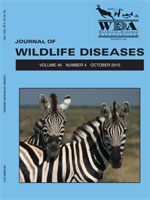The purpose of this study was to investigate the prevalence, intensity, and possible transmission routes of the trematode, Controrchis spp. (Dicrocoeliidae), in a population of black howler monkeys (Alouatta pigra) near Monkey River, Belize. Alouatta pigra are arboreal primates that are typically folivorous and frugivorous. Controrchis is a dicrocoeliid trematode and, as such, should require a gastropod and an ant (Formicidae) intermediate host for transmission. From January to July 2005 and February 2006 to June 2007, we collected fecal samples and focal animal data from 18 individual primates in four social groups. Feces were stored in either 10% buffered formalin or 95% ethanol and examined using a double-centrifugation sugar-flotation technique. The prevalence of Controrchis spp. was 89%, and the mean intensity was 2.29 eggs per gram (epg), with a range of 1.00–6.57 epg. A general linear mixed model to examine the effect of sex, rainfall, and time spent feeding on various plant species, while controlling for individual and group identity, revealed that both group and the amount of time spent feeding on trumpet trees (Cecropia peltata) by individuals predicted the prevalence and intensity of Controrchis spp. infestation. Cecropia peltata has a mutualistic relationship with Azteca spp. ants and constitutes an important food source for A. pigra. Our findings provide strong, circumstantial evidence that A. pigra are infected with Controrchis spp. through the ingestion of metacercariae in Azteca spp. when feeding on C. peltata. Because C. peltata is a pioneer tree species and typically occurs in disturbed forests, results from this study suggest an important link between habitat disturbance and parasitism in a wild mammal.
How to translate text using browser tools
1 October 2010
Parasites, Primates, and Ant-Plants: Clues to the Life Cycle of Controrchis spp. in Black Howler Monkeys (Alouatta pigra) in Southern Belize
Barbara K. Kowalzik,
Mary S. M. Pavelka,
Susan J. Kutz,
Alison Behie
ACCESS THE FULL ARTICLE

Journal of Wildlife Diseases
Vol. 46 • No. 4
October 2010
Vol. 46 • No. 4
October 2010
black howler monkey
Cecropia peltata
Controrchis spp.
habitat disturbance
myrmecophyte
parasite
parasitism




